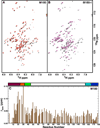A solution NMR investigation into the impaired self-assembly properties of two murine amelogenins containing the point mutations T21→I or P41→T
- PMID: 23896516
- PMCID: PMC3788651
- DOI: 10.1016/j.abb.2013.07.015
A solution NMR investigation into the impaired self-assembly properties of two murine amelogenins containing the point mutations T21→I or P41→T
Abstract
Amelogenesis imperfecta describes a group of inherited disorders that results in defective tooth enamel. Two disorders associated with human amelogenesis imperfecta are the point mutations T21→I or P40→T in amelogenin, the dominant protein present during the early stages of enamel biomineralization. The biophysical properties of wildtype murine amelogenin (M180) and two proteins containing the equivalent mutations in murine amelogenin, T21→I (M180-I) and P41→T (M180-T), were probed by NMR spectroscopy. At low protein concentration (0.1mM), M180, M180-I, and M180-T are predominately monomeric at pH 3.0 in 2% acetic acid and neither mutation produces a major structural change. Chemical shift perturbation studies as a function of protein (0.1-1.8mM) or NaCl (0-400mM) concentrations show that the mutations affect the self-association properties by causing self-assembly at lower protein or salt concentrations, relative to wildtype amelogenin, with the largest effect observed for M180-I. Under both conditions, the premature self-assembly is initiated near the N-terminus, providing further evidence for the importance of this region in the self-assembly process. The self-association of M180-I and M180-T at lower protein concentrations and lower ionic strengths than wildtype M180 may account for the clinical phenotypes of these mutations, defective enamel formation.
Keywords: Amelogenesis imperfecta; Amelogenin; Biomineralization; Enamel; Intrinsic disorder; Nanospheres.
Copyright © 2013 Elsevier Inc. All rights reserved.
Figures





Similar articles
-
Improved protocol to purify untagged amelogenin - Application to murine amelogenin containing the equivalent P70→T point mutation observed in human amelogenesis imperfecta.Protein Expr Purif. 2015 Jan;105:14-22. doi: 10.1016/j.pep.2014.09.020. Epub 2014 Oct 13. Protein Expr Purif. 2015. PMID: 25306873 Free PMC article.
-
A solution NMR investigation into the murine amelogenin splice-variant LRAP (Leucine-Rich Amelogenin Protein).Biochim Biophys Acta. 2010 Sep;1804(9):1768-74. doi: 10.1016/j.bbapap.2010.03.006. Epub 2010 Mar 19. Biochim Biophys Acta. 2010. PMID: 20304108 Free PMC article.
-
M180 amelogenin processed by MMP20 is sufficient for decussating murine enamel.J Dent Res. 2013 Dec;92(12):1118-22. doi: 10.1177/0022034513506444. Epub 2013 Sep 26. J Dent Res. 2013. PMID: 24072097 Free PMC article.
-
[Alteración del gen AMELX en amelogénesis imperfecta. Una breve revisión].Gac Med Mex. 2019;155(1):101-107. doi: 10.24875/GMM.18003604. Gac Med Mex. 2019. PMID: 30799455 Review. Spanish.
-
Controls of nature: Secondary, tertiary, and quaternary structure of the enamel protein amelogenin in solution and on hydroxyapatite.J Struct Biol. 2020 Dec 1;212(3):107630. doi: 10.1016/j.jsb.2020.107630. Epub 2020 Sep 24. J Struct Biol. 2020. PMID: 32979496 Free PMC article. Review.
Cited by
-
The flexible structure of the K24S28 region of Leucine-Rich Amelogenin Protein (LRAP) bound to apatites as a function of surface type, calcium, mutation, and ionic strength.Front Physiol. 2014 Jul 11;5:254. doi: 10.3389/fphys.2014.00254. eCollection 2014. Front Physiol. 2014. PMID: 25071599 Free PMC article.
-
Improved protocol to purify untagged amelogenin - Application to murine amelogenin containing the equivalent P70→T point mutation observed in human amelogenesis imperfecta.Protein Expr Purif. 2015 Jan;105:14-22. doi: 10.1016/j.pep.2014.09.020. Epub 2014 Oct 13. Protein Expr Purif. 2015. PMID: 25306873 Free PMC article.
-
High-yield recombinant bacterial expression of 13 C-, 15 N-labeled, serine-16 phosphorylated, murine amelogenin using a modified third generation genetic code expansion protocol.Protein Sci. 2023 Feb;32(2):e4560. doi: 10.1002/pro.4560. Protein Sci. 2023. PMID: 36585836 Free PMC article.
-
Dose-Dependent Rescue of KO Amelogenin Enamel by Transgenes in Vivo.Front Physiol. 2017 Nov 16;8:932. doi: 10.3389/fphys.2017.00932. eCollection 2017. Front Physiol. 2017. PMID: 29201008 Free PMC article.
-
Solid-State NMR Identification of Intermolecular Interactions in Amelogenin Bound to Hydroxyapatite.Biophys J. 2018 Nov 6;115(9):1666-1672. doi: 10.1016/j.bpj.2018.08.027. Epub 2018 Aug 29. Biophys J. 2018. PMID: 30415654 Free PMC article.
References
-
- Ten Cate AR. Oral histology: developement, structure, and function. Mosby: St. Louis; 1994.
-
- Shore RC, Robinson J, Kirkham J, Brookes SJ. In: Dental Enamel from Formation to Destruction. Robinson C, Kirkham J, Shore RC, editors. Boca Raton: CRC Press; 1995. p. 151.
-
- White SN, Luo W, Paine ML, Fong H, Sarikaya M, Snead ML. J. Dent. Res. 2001;80:321–326. - PubMed
-
- Hunter G. Curr. Opin. Mat. Sci. 1996;1:430–435.
-
- Margolis HC, Beniash E, Fowler CE. Crit. Rev. Oral Biol. Med. 2006;85:775–793. - PubMed
Publication types
MeSH terms
Substances
Grants and funding
LinkOut - more resources
Full Text Sources
Other Literature Sources
Molecular Biology Databases

